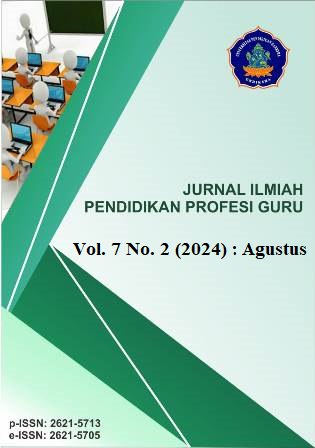Revolutionizing Science Education Evaluation Using a Vision Language Model of Effective Assessment and Supervision
DOI:
https://doi.org/10.23887/jippg.v7i2.79101Keywords:
Vision Language Models, Independent Curriculum, Teaching at the Right Level, Good PracticesAbstract
Implementing the Independent Curriculum in Indonesia presents challenges in educational assessment, especially in efficiently evaluating students' essay responses. This study aims to develop and test an educational evaluation model based on artificial intelligence (AI) technology, especially the vision language model, which can automate and improve the process of assessing student learning outcomes in science. This study explores the potential of Vision Language Models (VLMs) as an innovative solution. This study uses a mixed sequential explanatory method. The subjects in this study were junior high school students. The data collection method used interviews. Data collection instruments with questionnaires. Data analysis techniques used were qualitative, quantitative, descriptive analysis, and inferential statistics. The study results are that integrating VLMs increases the efficiency and objectivity of assessment. This study concludes that VLMs can reduce teacher workload, improve feedback, and show synergy between technology and curriculum reform in the Independent Curriculum era. The implications of this study are very significant for the development of science and technology education; the use of vision language models (Vision-Language Models) in evaluating science education can increase the accuracy and objectivity in assessing student learning outcomes.
References
Aprilia, N. D., & Madiun, U. P. (2024). Pengembangan Media Smart Apps dalam Pembelajaran Ekosistem Kelas V Sekolah Dasar Materi. Sennasdra, 3(3), 715–722.
Belenggu, M. D., Curry, L. A., & Creswell, J. W. (2020). Achieving integration in mixed methods designs-principles and practices. Health Serv Res, 48(6pt2), 2134–2156. https://doi.org/10.1111/1475-6773.12117.
Braun, V., & Clarke, V. (2021). Using thematic analysis in psychology. Penelitian Kualitatif dalam Psikologi, 3(2), 77–101. https://doi.org/10.1191/1478088706qp063oa.
Chen, X., Xie, H., Zou, D., & Hwang, G. J. (2021). Tinjauan sistematis analisis pembelajaran multimodal dalam pendidikan sains: Masalah metodologis, topik penelitian, dan arah masa depan. Tinjauan Penelitian Pendidikan, 38(2), 100474.
Fan, H., Zhang, H., Ma, C., & Wu, T. (2024). Enhancing metal additive manufacturing training with the advanced vision language model: A pathway to immersive augmented reality training for non-experts. Journal of Manufacturing Systems, 75. https://doi.org/10.1016/j.jmsy.2024.06.007.
Grace, Y., benardi, Permana, N., & Wijayanti, F. (2023). Transformasi Pendidikan Indonesia: Menerapkan Potensi Kecerdasan Buatan (AI). Journal of Information Systems and Management, 2(6), 102–106. https://doi.org/10.4444/jisma.v2i6.1076.
Guetterman, T. C., Fetters, M. D., & Creswell, J. W. (2020). Integrating Quantitative and Qualitative Results in Health Science Mixed Methods Research Through Joint Displays. Ann Fam Med, 13(6), 554–561. https://doi.org/10.1370%2Fafm.1865.
Ivankova, N. V. (2019). Pembelajaran Efektif. Jurnal Internasional Metodologi Penelitian Sosial, 21(4), 409–424.
Johnson, R. B., Onwuegbuzie, A. J., & Turner, L. A. (2023). Toward a Definition of Mixed Methods Research. Journal of Mixed Methods Research. Jurnal Penelitian Metode Campuran, 1(2), 112–133. https://doi.org/10.1177/1558689806298224.
Kallio, H., Pietilä, A. M., Johnson, M., & Kangasniemi, M. (2023). Systematic methodological review: developing a framework for a qualitative semi-structured interview guide. Adv Nurs, 72(12), 2954–2965. https://doi.org/10.1111/jan.13031.
Kim, T. K. (2021). T test as a parametric statistic. Korean J Anesthesiol, 68(6), 540–546. https://doi.org/10.4097/kjae.2015.68.6.540.
Lee, S. C., Yeung, S. S., & Cheung, W. M. (2022). Meningkatkan keterampilan literasi anak melalui program intervensi membaca dialogis: Sebuah studi multi-baseline. Jurnal Penelitian Membaca, 44(2), 347–365.
Mertens, D. M., & Hesse-Biber, S. (2018). Triangulation and mixed methods research: Provocative positions. Journal of Mixed Methods Research, 6(2), 75–79. https://doi.org/10.1177/1558689812437100.
Mogadala, A., Kalimuthu, M., & Klakow, D. (2020). Trends in integration of vision and language research: A survey of tasks, datasets, and methods. Journal of Artificial Intelligence Research, 71(2), 1183–1317. https://doi.org/10.48550/arXiv.1907.09358.
Morgan, D. L. (2020). Commentary—After triangulation, what next? Journal of Mixed Methods Research, 13(1), 6–11. https://doi.org/10.1177/1558689818780596.
Moskal, B. M., & Leydens, J. A. (2022). Scoring rubric development: Validity and reliability. Practical Assessment, Research, and Evaluation, 7(1), 10.
Muhali. (2018). Arah Pengembangan Pendidikan Masa Kini Menurut Perspektif Revolusi Industri 4.0. Prosiding Seminar Nasional Lembaga Penelitian dan Pendidikan (LPP) Mandala, 23(7), 1–14.
Nabhan, G., Alkhawa, N., & Qulub, T. (2023). Tren Perkembangan Pembelajaran Termokimia Dalam Waktu Lima Tahun Terakhir. Prosiding Seminar Nasional, 34(32), 88–99.
Nehm, R. H., Ha, M., & Mayfield, E. (2022). Transforming biology assessment with machine learning: Automated scoring of written evolutionary explanations. Journal of Science Education and Technology, 21(1), 183–196. https://doi.org/10.1007/s10956-011-9300-9.
Ouhaichi, H., Spikol, D., & Vogel, B. (2023). Research trends in multimodal learning analytics: A systematic mapping study. Computers and Education: Artificial Intelligence, 4. https://doi.org/10.1016/j.caeai.2023.100136.
Prawiyogi, A. G., Rahman, R., Sastromiharjo, A., Sulistiawati, S., & Aini, Q. (2021). Ontologi Blockchain Pada Karya Tulis Puisi Di Pendidikan Sekolah Dasar : Metode Merkle Root. Computer Science Reseach and Its Development Journal, 13(1). https://doi.org/10.22303/csrid.13.1.2021.24-34.
Rukmana, A. Y., Supriandi, & Wirawan, R. (2023). Penggunaan Teknologi dalam Pendidikan: Analisis Literatur Mengenai Efektivitas dan Implementasi. Jurnal Pendidikan West Science, 1(07), 460–472. https://doi.org/10.58812/jpdws.v1i07.541.
Schober, P., Boer, C., & Schwarte, L. A. (2022). Correlation coefficients: Appropriate use and interpretation. Anestesi & Analgesia, 126(5), 1763–1768. https://doi.org/10.1213/ane.0000000000002864.
Schoonenboom, J., & Johnson, R. B. (2023). How to construct a mixed methods research design. KZfSS Kölner Zeitschrift Für Soziologie Und Sozialpsychologie, 69(2), 107–131.
Tamu, G., Bunce, A., & Johnson, L. (2021). Berapa banyak wawancara yang cukup? Eksperimen dengan saturasi dan variabilitas data. Metode Lapangan, 18(1), 59–82.
Vyas, M., Kaur, A., & Kaur, A. (2020). Text classification algorithms: A survey. Journal of Information Technology, 11(3), 421–427.
Zhao, T., Qiu, H., Dai, Y., & Wang, L. (2024). VLM-guided Explicit-Implicit Complementary novel class semantic learning for few-shot object detection. Expert Systems with Applications, 256. https://doi.org/10.1016/j.eswa.2024.124926.
Downloads
Published
How to Cite
Issue
Section
License
Copyright (c) 2024 Irfan Ananda Ismail, Khairil Arif; Andromeda Andromeda, Yerimadesi Yerimadesi; Qadriati Qadriati; Munadia Insani

This work is licensed under a Creative Commons Attribution-ShareAlike 4.0 International License.

Jurnal Ilmiah pendidikan profesi guru is licensed under a Creative Commons Attribution-ShareAlike 4.0 International License.






